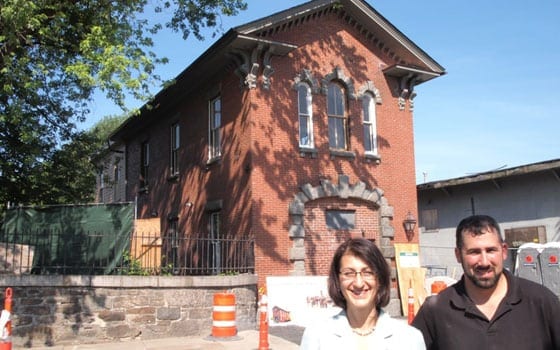

Author: Yawu MillerHistoric Boston Incorporated Executive Director Kathy Kottaridis and Construction Supervisor Brian Gossens in front of the Eustice Street Firehouse. The building will serve as offices for HBI and is expected to inject new life into a long-neglected historic corner of Roxbury.
An historic Dudley Square building is getting a second lease on life thanks to an extensive renovation by Historic Boston Incorporated (HBI).
HBI will move into the Eustice Street Firehouse in September. HBI’s new location, next to the historic Roxbury Burial Ground, is expected to inject new life into the Eustice Street Historical District, a corner of Dudley Square that has deep connections to Roxbury’s colonial and 19th century past.
“This is great because we were about to lose that building,” says Dudley Square Main Streets Director Joyce Stanley. “There’s a lot of history there.”
The Eustice Street Firehouse was state of the art when it was built in 1859. The two-story Italianate structure replaced an out-moded wooden building and housed a truck with a steam-powered pump. It is the oldest remaining firehouse in the city.
Unfortunately for the 19th century fire fighters, the steam power was only for pumping. Transporting the truck to fires was their job. Horses weren’t added to the station until nine years later when stables were added to the back of the building.
In 1859, the gas fired internal combustion engine was still in development, the first oil well in the United States was drilled in Pennsylvania and Roxbury was still a small town, nine years away from being annexed by Boston, which had already begun filling in the South Bay to create what is now the South End.
The firehouse served the town, and later the city of Boston, well. Members of the fire station helped fight the great fire of 1872 which consumed 60 acres in what is now Boston’s financial district. When the small firehouse closed in 1922 and was taken over by a group of Spanish-American War veterans, horse drawn fire trucks were rapidly becoming a thing of the past.
The firehouse was condemned to history’s dustbin, fading into disuse next to the Colonial-era Roxbury Burial Ground, the Nawn Factory and other relics of the Town of Roxbury.
After the Spanish-American War vets petered out in 1950, the building served as storage for the city’s Department of Public Works, languishing under the shadow of the elevated Orange Line.
“When we first got into the upstairs offices, there were still papers from the Spanish War Veterans,” says HBI Executive Director Kathy Kottaridis.
HBI will have offices on the building’s second floor and the first floor will house the offices of the Timothy Smith Network, a nonprofit that provides technology education to Boston children.
The building underwent extensive renovations, including foundation work, the reconstruction of sections of the brick exterior and reconditioning of the buildings original window casings, performed by students at the North Benett Street School’s Preservation Carpentry Division.
The building is now integrated into the Eustice Street Historical District, which includes the Roxbury Burial Ground, which along with the Granary Burial Ground and the Copp’s Hill cemetery, is one of the three oldest in Boston.
Of those three, all of which were established in 1630 when the Puritans first arrived in Boston, the Roxbury cemetery is the only one which has not been re-landscaped. Although sections of the cemetery were taken over by streets in Dudley Square, the center of the burial ground remains untouched, with the remains of the Dudley family (including two Massachusetts governors), and Puritan pastors from the nearby First Church of Roxbury are interred in their original crypts.
“This is one of the few pieces of Roxbury that’s undisturbed from the 1630s,” Kottaridis says. “Here, everything is as it was.”
Unlike the other colonial-era cemeteries, the Roxbury Burial Ground still has foot stones — smaller markers that were placed at the foot of colonists’ graves. The earliest grave dates to 1633 — three years after the Puritans first arrived in Boston and Roxbury.
The Firehouse, like Washington Street, was built on land formerly claimed by the moldering bodies of the colonists. When contractors rebuilt the building’s foundation, they had to sift carefully through the dirt, taking care to preserve what archeologists call “disarticulated remains.”
“We had to sift all of it, store it with an archeologist, or re-inter it on site,” Kottaridis says. “All the excavated dirt on this site has something in it.”
The attitudes toward historical preservation have evolved since the Firehouse was built in 1859. And the Eustice Street Historical district’s preservation has taken a step forward with the redevelopment of the Firehouse, according to Kottaridis, who says HBI will explore ways to open the cemetery open to the public for the first time in decades.
“We’ll literally be the eyes and ears here,” she said. “We can find ways to keep this historic district alive.”
Next in HBI’s sights is the historic Nawn Factory, built and used by real estate developer Owen Nawn, who built the elevated Orange Line.







